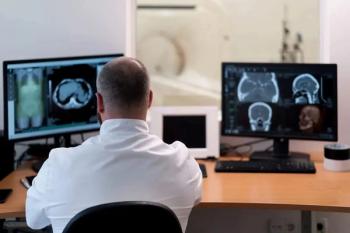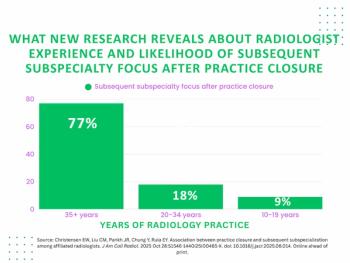
Emergency Preparedness in Radiology
How radiologists weather the storm.
“All the roads were flooded in Houston around the hospital,” said Susan John, MD, chair of diagnostic and interventional imaging at the University of Texas Health Sciences Center. “No one came in or out after Saturday night, and the waters didn’t recede until Monday.”
That was the scene in the aftermath of Hurricane Harvey, a Category 3 storm that hit Houston in late August, causing massive destruction and city-wide flooding. In the middle of the havoc, though, medical personnel, including radiologists, continued to provide necessary patient care services.
Staying active during and following a hurricane is possible, she said. To do so, though, practices and departments must follow emergency protocols. In many cases, especially for radiologists affected by Harvey and Hurricane Irma, a Category 3 storm that struck south Florida in early September, these policies were the result of lessons learned from past experiences.
They can serve as a guide for you or others if you, one day, find yourself facing a hurricane. And, if you handle preparedness well, said Benjamin Freedman, MD, chief of radiology at Memorial Healthcare System in Florida, you’ll not only safeguard your quality of care, but you could also improve your relationships.
“Sharing a safe place really can serve to strengthen the relationship between the group of radiologists working together and the referring physicians, technologists, staff, and administrators,” he said.
Planning Personnel
Establish a coverage schedule well in advance of a storm, Freedman said. Don’t wait to assign shifts at the last minute - that creates unneeded stress and confusion. Additionally, plan to have enough providers and staff on-hand during the storm. Adequate personnel is critical, he said.
“It’s the natural inclination during a storm to have as few people at the hospital as possible to keep your staff safe,” he said. “But, you actually need enough people there so everyone working during the storm won’t get burned out over the several days everyone might be stuck in the hospital.”
Texas’s Heath Science Center, which serves Memorial Hermann Healthcare System and Lyndon B. Johnson Hospital, addressed this problem by relying on existing work schedules to assign hurricane coverage. Instead of creating new hurricane schedules, staff already scheduled to work when the hurricane hit stayed on call during the storm, John said. They were divided into two teams - ride out (those who stayed in-house and worked during the storm) and recovery (those who provided aftermath relief).
Communicate clearly, early, and often with your staff, she said, so they know which team they’re on.
“People need to have enough time to make arrangements for their families and to prepare themselves mentally, physically, and emotionally,” she said.
Changing teams can be tricky after a storm, said Kelly Burton, imaging manager for Houston Methodist Willowbrook Hospital. It can take a while for your recovery team to safely make it back to work, and you must maintain staffing until then. Her facility ensured enough staff were on hand by requiring ride out and recovery team members to physically “High 5” as they traded spots - that way, she said, everyone knew their replacement had arrived.[[{"type":"media","view_mode":"media_crop","fid":"63811","attributes":{"alt":"Emergency preparedness in radiology","class":"media-image media-image-right","id":"media_crop_7979221086149","media_crop_h":"0","media_crop_image_style":"-1","media_crop_instance":"8135","media_crop_rotate":"0","media_crop_scale_h":"0","media_crop_scale_w":"0","media_crop_w":"0","media_crop_x":"0","media_crop_y":"0","style":"height: 151px; width: 200px; border-width: 0px; border-style: solid; margin: 1px; float: right;","title":"©Stuart Miles/Shutterstock.com","typeof":"foaf:Image"}}]]
Work with IT Staff
Before any major storm hits, Freedman said, talk with your IT staff about any steps needed to strengthen your PACS system or how you or your colleagues might be able to provide services remotely.
In addition, work with IT personnel to disseminate all downtime procedures so everyone knows the process for continuing to provide care if your facility loses communication capabilities during the storm.
“We had a book of downtime procedures at every work station so if communications or power went down and we were dependent on a generator, our radiologists would still know what to do,” he said.
The handbook was helpful, he said, when one CT scanner lost contact with the Memorial PACS system. Instead of halting services, radiologists read and interpreted studies off the scanner itself.
Keep Images Safe
Digital images are easier to protect than film, but there are still steps you can take as added safeguards, said Michael Yuz, MD, executive radiologist at USARAD, a radiology-on-demand company. Yuz was affected by Hurricane Irma.
If your practice or hospital is in a high-risk area, be sure you have redundancy built into your system. For example, USARAD’s servers with patient images are located in areas with low vulnerability to flooding or excessive winds, he said. And, the servers synchronize continuously so there’s no chance of losing studies.
It’s also helpful, he said, to give radiologists equipment needed to work from home, if you can. Laptops and smartphones that can access your PACS system can be excellent tools to have on-hand.
“For us, everyone had the capacity to work from home,” he said. “That’s done for a reason. Hurricanes, floods, earthquakes - our operations won’t be paralyzed when these things happen.”
Physical safeguards can also be necessary. According to Ezequiel Silva, MD, president of the Texas Radiological Society and chair of the ACR Commission on Economics, from Houston’s Texas Medical Center learned this lesson after 2001’s Tropical Storm Allison - they installed floodgates to protect imaging equipment housed in the facility’s lower levels.
Challenges
Even with protocols in place, providing quality care during a storm can be difficult, John said. Maintaining clear communication is a challenge in large hospitals. In those cases, radiologists can benefit from resource guides with information about where providers can shower, sleep, and find food.
“Hospitals usually communicate things through charge nurses, but we don’t have those in radiology,” she said. “We’re not often where patients are, so during storms, hospitals don’t frequently know where we are or how to communicate with us.”
Additionally, for the next storm, John said providers will conduct twice-daily calls between all emergency team leaders.
Conserving your resources can also be challenging during a storm, Burton said. To minimize your pull on the hospital, identify only what you need to continue providing care. For example, she said, outpatients don’t come to the hospital during storms, so consider shutting down your interventional radiology room until that changes. You can also minimize the number of machines you operate - don’t keep four MRI machines running when you only need one.
The Aftermath & Next Steps
Overall, radiology and its practitioners have learned much in the past decade about how best to weather natural disasters. Each storm still brings new dangers and lessons learned, and there’s always room for improvement, Silva said.
“When I talked with people after Harvey, you could tell they were shaken, but they were functional,” he said. “Instead of reporting being devastated by flooding or having operations shut down, they said they’d have services back up the next day, and medical schools said students would be back in the classroom within the week. It was comforting and encouraging.”
Still, Silva added, the industry could benefit from having ACR guidance on how best to prepare for natural disasters. The most comprehensive advice will include input from states that have repeatedly experienced these situations before.
“In the medical community, we do a good job of preparing for general medical care around disasters,” Silva said. “But, we still need better guidance for what radiologists need to do and what lessons they can learn from radiologists who have been through these situations.”
Newsletter
Stay at the forefront of radiology with the Diagnostic Imaging newsletter, delivering the latest news, clinical insights, and imaging advancements for today’s radiologists.





























